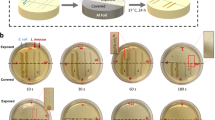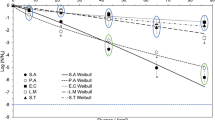Abstract
Aluminum based reflective nanolens arrays were developed via a series of aluminum electropolishing and anodization steps with subsequent selective dissolution of anodic aluminum oxide (AAO). The diameter of nanolenses (d) on arrays can be controlled by altering electrolytes and voltages used for aluminum anodization. The d values of arrays produced by anodization in 0.3 M oxalic acid at 40, 60, and 80 V, and in 1.0 M phosphoric acid at 100, 110, and 120 V were 71.94, 121.90, and 161.53 nm, and 220.16, 252.06, and 274.78 nm, respectively. The effectiveness of UV (254 nm) inactivation of Escherichia coli O157:H7 and Listeria monocytogenes at concentrations of 5–6 log CFU/mL in water and in a 10% (w/v) sucrose solution was improved using a nanolens array having a d value of 252.06 nm.






Similar content being viewed by others
References
ASTM (2014) Standard test method for seal quality of anodic coatings on aluminum by acid dissolution. American Society for Testing and Materials (ASTM) International: West Conshohocken B680-80
Chatterley C, Linden K. Demonstration and evaluation of germicidal UV-LEDs for point-of-use water disinfection. J Water Health. 8: 479-486 (2010)
Cheng C, Ngan AHW (2015) Theoretical pore growth models for nanoporous aluminums. In: Losic D, Santos A (eds) Nanoporous alumina: fabrication, structure, properties and applications. Springer, New York, pp. 31-60
Cohen MB, Giannella RA. Hemorrhagic colitis associated with Escherichia coli O157:H7. Adv Intern Med. 37: 173-195 (1992)
Farber JM, Peterkin PI. Listeria monocytogenes, a food-borne pathogen. Microbiol Rev. 55: 476-511 (1991)
Hijnen WAM, Beerendonk EF, Medema GJ. Inactivation credit of UV radiation for viruses, bacteria and protozoan (oo)cysts in water. Water Res. 40: 3-22 (2006)
Hou Y, Li R, Liang J. Simultaneous electropolishing and electrodeposition of aluminum in ionic liquid under ambient conditions. Appl Surf Sci. 434: 918-921 (2018)
Islam MS, Patras A, Pokharel B, Wu Y, Vergne MJ, Shade L, Xiao H, Sasges M. UV-C irradiation as an alternative disinfection technique: study of its effect on polyphenols and antioxidant activity of apple juice. Innov Food Sci Emerg Technol. 34: 344-351 (2016)
Keller F, Hunter MS, Robinson DL. Structural features of oxide coatings on aluminum. J Electrochem Soc. 100: 411-419 (1953)
Kowalski W (2009) UVGI disinfection theory. In: Kowalski W (ed) Ultraviolet germicidal irradiation handbook: UVGI for air and surface disinfection. Springer, Berlin, pp. 17-50
Lee W (2015) Structural engineering of porous anodic aluminum oxide (AAO) and applications. In: Losic D, Santos A (eds) Nanoporous alumina: Fabrication, structure, properties and applications. Springer, New York, pp. 107-153
Ling Z, Li Y (2015) Mechanisms of nanoporous alumina formation and self-organized growth.. In: Losic D, Santos A (eds) Nanoporous alumina: fabrication, structure, properties and applications. Springer, New York, pp. 1-30
Ono S, Masuko N. Evaluation of pore diameter of anodic porous films formed on aluminum. Surf Coat Technol. 169-170: 139-142 (2003)
Oppezzo OJ, Pizarro RA. Sublethal effects of ultraviolet A radiation on Enterobacter cloacae. J Photochem Photobiol B: Biol. 62: 158-165 (2001)
Shachman M. The soft drinks companion: a technical handbook for the beverage industry. CRC Press, Boca Raton (2005)
Sommer R, Cabaj A, Haider T. Microbicidal effect of reflected UV radiation in devices for water disinfection. Water Sci Technol. 34: 173-177 (1996)
Tortora GJ, Funke BR, Case CL. Microbiology: an introduction. Pearson Education, San Francisco (2015)
Tsao Y-C, Søndergaard T, Skovsen E, Gurevich L, Pedersen K, Pedersen TG. Pore size dependence of diffuse light scattering from anodized aluminum solar cell backside reflectors. Opt Express. 21: A84-A95 (2013)
Ventura EE, Davis JN, Goran MI. Sugar content of popular sweetened beverages based on objective laboratory analysis: focus on fructose content. Obesity 19: 868-874 (2011)
Acknowledgments
This study was supported by a grant from the National Research Foundation of Korea (NRF-2016R1A2B1012571) funded by the Korean government.
Author information
Authors and Affiliations
Corresponding author
Ethics declarations
Conflict of interest
The nanolens array manufactured and used for this report is protected by Korea patent filing serial number ‘10-2018-0106899’, “Ultraviolet sterilizing apparatus using a lens array,” filed Sep 7, 2018. This does not alter author adherence to all Food Science and Biotechnology policies regarding sharing data and materials.
Additional information
Publisher's Note
Springer Nature remains neutral with regard to jurisdictional claims in published maps and institutional affiliations.
Electronic supplementary material
Below is the link to the electronic supplementary material.
Rights and permissions
About this article
Cite this article
Park, J., Chai, C. Aluminum based reflective nanolens arrays to improve the effectiveness of ultraviolet inactivation of Escherichia coli O157:H7 and Listeria monocytogenes in water and a sucrose solution. Food Sci Biotechnol 29, 1281–1287 (2020). https://doi.org/10.1007/s10068-020-00765-z
Received:
Revised:
Accepted:
Published:
Issue Date:
DOI: https://doi.org/10.1007/s10068-020-00765-z




